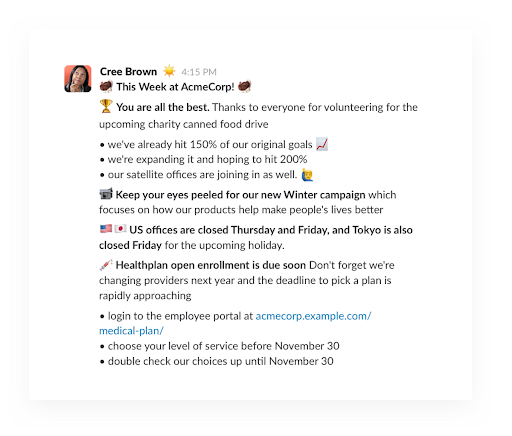HR leaders: Learn to effectively communicate with your workforce in six steps.
In 2022, nearly 40% of employees reported that they received an excessive volume of communications at their organization[1]. And worse, 33% of employees said the messages were “often inconsistent or internally conflicting.”
It can be easy for employees to feel overloaded and confused by internal communications, which can add to change fatigue. In order to avoid essential information getting lost in the noise, HR leaders need to adopt an effective communication strategy.
Using Gartner research, we’ve identified a six-step internal communication plan that is adaptable enough to cover a variety of message types, whether you need to promote new benefits offerings or announce organizational changes.
Ready to hire a recruiting agency for your business needs? Browse our list of companies in the following areas:
The cost of ineffective HR communication
The bottom line (pun intended) when it comes to ineffective internal communication is that it costs your company—and in more ways than you might think:
Miscommunications cost small companies (defined as businesses with 100 employees or less) an average of $420,000 per year, according to SHRM[3]. At their worst, they could even result in a lawsuit[2].
Miscommunications can result in difficulties recruiting and retaining talent or fostering a productive workplace.
In order to get things on track, follow the six steps outlined below.
Step 1: Develop an action plan
A communication action plan is a detailed guide covering the steps needed to get the right information to the right groups within the organization. Anytime you need to deliver formal communications, you should develop an action plan.
Every communication action plan should include the following:
Goal: What’s the purpose of the communication?
Who: Who’s responsible for crafting and delivering the communication?
Audience: Who are the intended recipients?
Channel(s): How will the communication be delivered?
Timeframe: When should the message be delivered?
Follow-up: What actions need to be taken post communication, and when?
Free Download: Capterra's Communication Action Plan Template
Creating action plans will add structure and organization to your communication strategy. It will also help you determine how effective your language and channels are because you’ll have a record of how you executed.
/ Planning in practice
Download our communication action plan template and use it to map out your next few HR communications. We recommend working on this with a communications specialist (if your organization has one). Use the graphic in step two to determine which channel is the most appropriate for your message.
Step 2: Define your purpose
Before you communicate with members of your workforce, take time to clearly define the intended outcome of your communication. For example, are you trying to elicit action by getting workers to participate in a new employee resource group (ERG)? Or are you simply informing them of changes to your benefits program?
The idea is to determine whether or not you want employees to act upon the information you’re sharing with them—and to make that clear if you do. Your purpose should always be aligned to one of these 5 kinds[]:
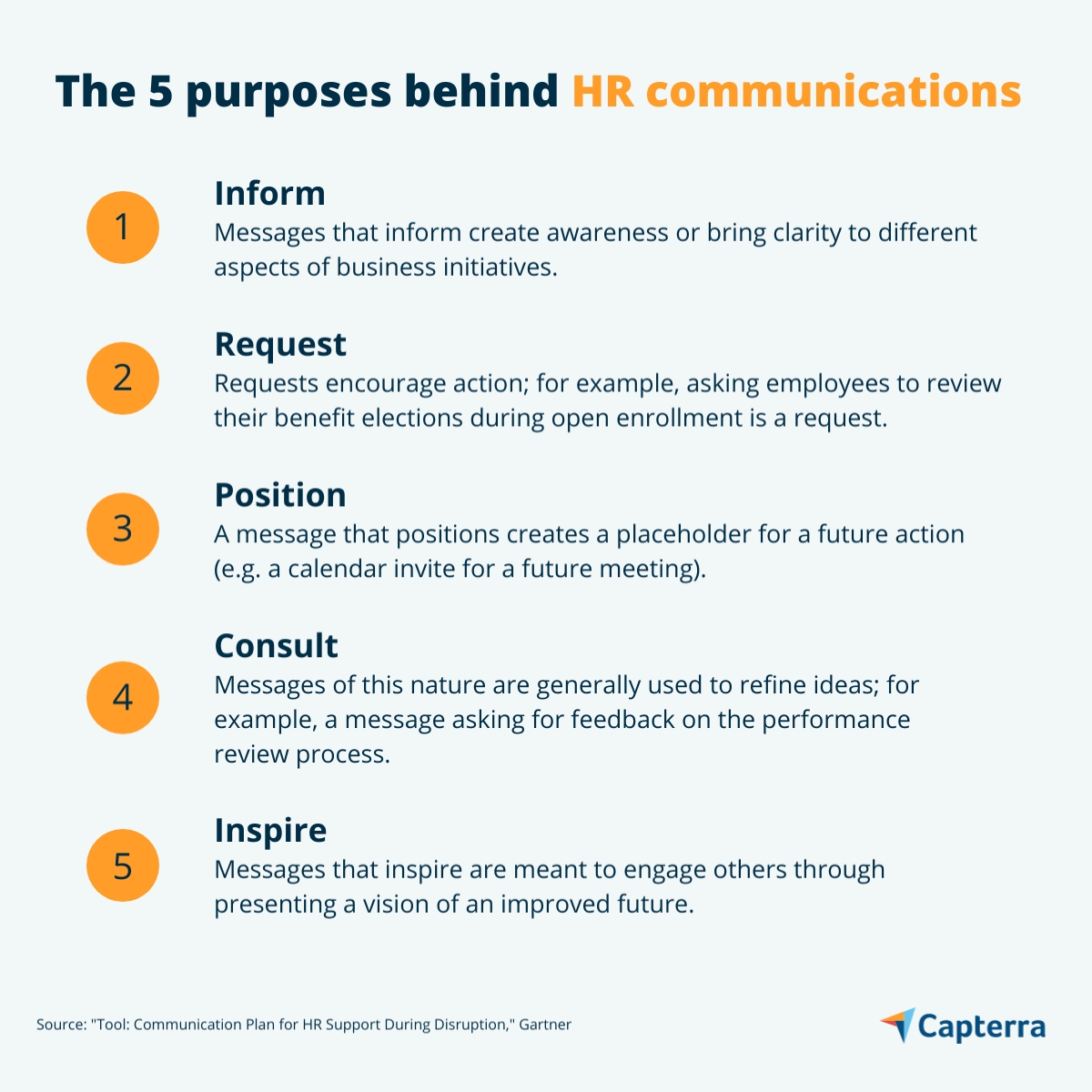
/ Planning in practice
Use the five types of communication purposes listed above to determine the intent behind your department’s last few outreach actions. Then, decide whether the language and communication channel you used were effective in driving the desired outcome.
Step 3: Choose the right channels
Once you know the purpose of your communication, determine which channels you’ll use to communicate.
Every business has different channels at their disposal, but here are some examples of common communication channels and when it’s best to use them:
Channel type | Example | Communication purpose |
|---|---|---|
Leader communications (i.e. one-to-many) | Town hall meetings | To engage with or motivate employees, and make important organization-wide announcements |
Central communications (i.e. one-to-many) | Company slide decks and collateral | To update a specific (large) group about upcoming initiatives or priorities |
Manager dialogue (i.e. one-to-few or one-to-one) | One-on-ones, team meetings | To problem solve, gather employee feedback, or translate a plan into action |
Employee-to-employee (i.e. interactive) | Using collaboration software or a company intranet | Employee communication and collaboration |
Of course, employee preferences matter when it comes to choosing the right communication channels. A recent survey[5] polled 988 employees from North America, Asia, and Europe about their communications preferences, and results showed most people prefer to hear news from their managers, presumably the most trusted source of communication:
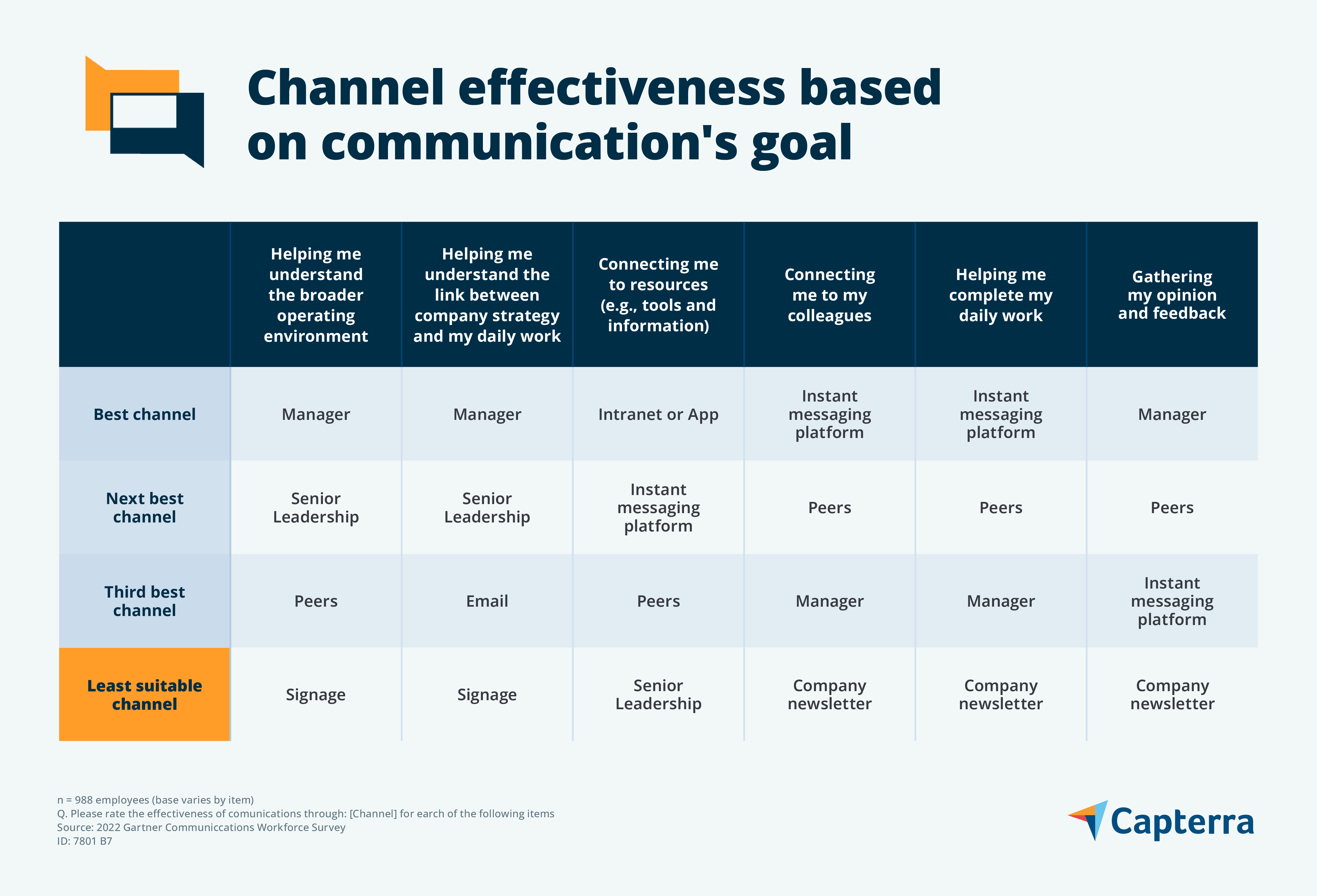
Instant messaging (a feature of most team communication platforms) is also frequently used, considered the most useful and second-most effective channel behind peers.
/ Planning in practice
Follow these three steps to make sure you're communicating through the most effective channels.
Audit your current channel mix. Write down the channels your team uses to get information out.
Survey your workforce and ask them how they prefer to receive company news. Use a survey tool to do this or have managers ask their reports during one-on-ones.
Create a communications channel guide. Identify the best uses for each channel and create a resource that guides your HR team in the right direction.
Pro tip
Double down. If you need a response or action to be taken, don’t solely rely on a single, but rather send an email and reinforce or remind folks with the intranet.
Step 4: Focus on messaging
Once you’ve determined the goal and the appropriate channels, it’s time to craft your message. Considering that over a fourth (27%) of all employees and over a third (35%) of managers feel overloaded by information at work, it’s essential to keep the contents of your message focused and short[6].
Whether you’re preparing an email, an announcement post, an instant message, or a slide deck, the following best practices should prevent your communications from being overlooked.
When composing a formal email, use the subject line to inform the recipients of the goal of your communications. This makes it easier for those scanning full inboxes to determine how the contents of the email will impact them, and it will also help them find the email later on.
Pro tip
If you need a response or for folks to take action on the email, let them know in the subject line (see example below).
Example: “[ACTION REQUIRED] Submit Your Town Hall Questions By EOW!”
After greeting the group or individual you’re reaching out to, get to the point quickly within the body of your email. Use bolded text to draw attention to any follow-up actions they need to take, then sign off with a professional signature.
Announcement posts
Composing a post for a workplace communication channel or your company’s intranet is similar to writing an email, but you can use a slightly less formal tone and more formatting options to get your point across.
In lieu of a subject line, use the first line of your message to summarize what your audience is about to read. Then, use line breaks and bolded text to call attention to different key points within the body of your message.
Slide decks and presentations
Presentations and slide decks provide extra “runway” for extraneous details and context, but even so, the same rules apply: Keep your text short and to-the-point when possible. A benefit of slide decks and presentations is the ability to use visuals more effectively, but you should be judicious here, too.
The 5/5/5 rule
Use the 5/5/5 rule to ensure your presentations are engaging and don’t overload your audience with information. The 5/5/5 rule for creating slide decks is as such: Include no more than five words per line of text, five lines of text per slide, or five text-heavy slides in a row in your presentation.
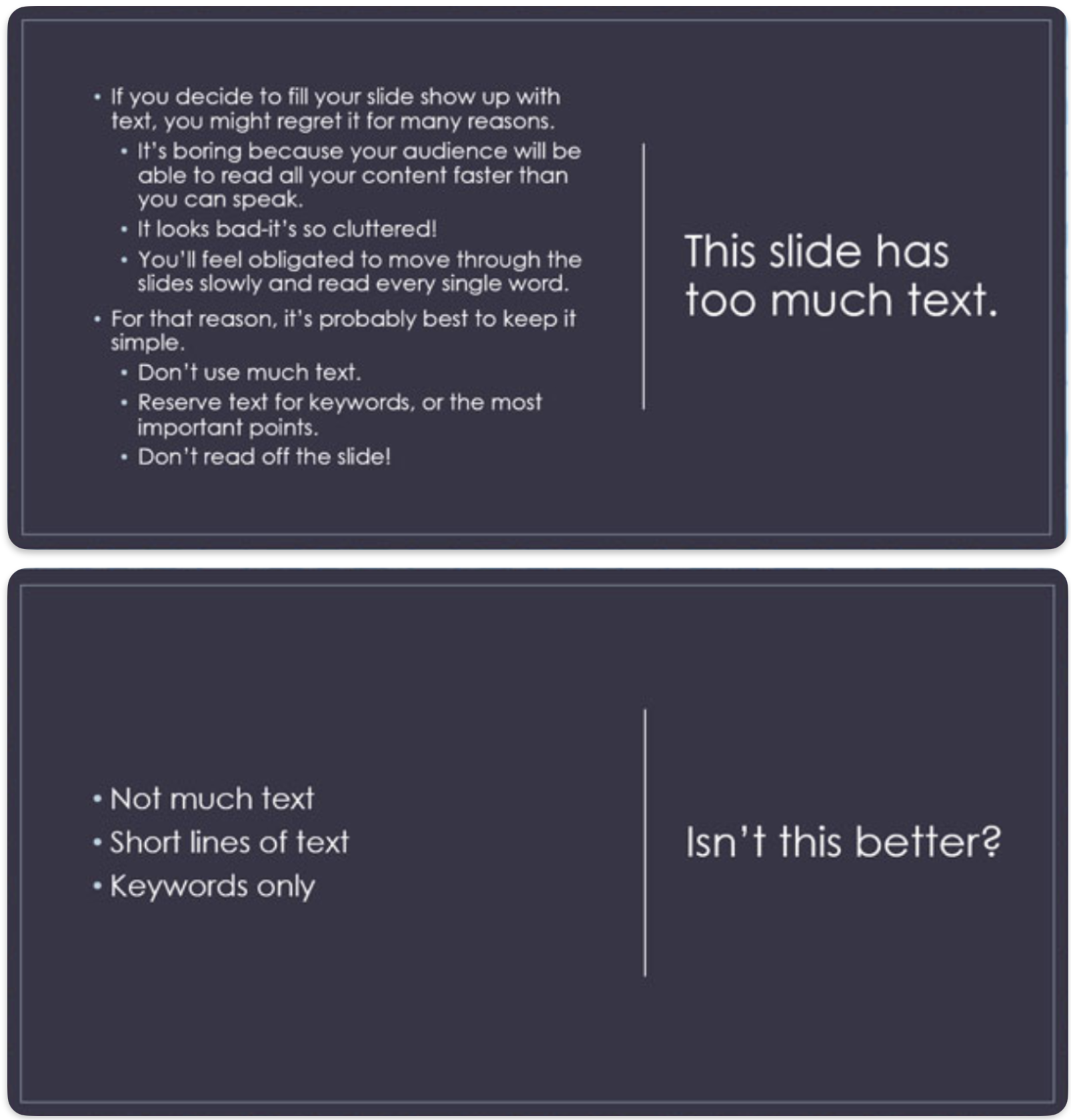
An example showing the power of the 5/5/5 rule[8]
Instant messages
Instant messaging is the channel that best supports two-way communication, making it ideal for coordinating meetings, recognizing employees’ accomplishments, and delivering progress updates to team members about ongoing projects or processes.
When instant messaging, keep your communication short and use a positive, productive tone. Also, avoid sending any confidential information in an instant message as that can lead to legal snafus[9].
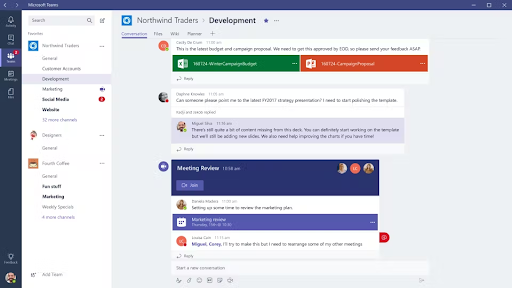
Back-and-forth communication between coworkers in Teams (Source)
Step 5: Prepare managers to support employees
Earlier on, we mentioned that employees prefer to receive communications through their managers. Your internal communications strategy depends upon managers having the communications skills not only to deliver information to their direct reports but also to carry on a dialogue with them.
Enlist a communications specialist (such as the individual who currently leads internal comms) to train managers on appropriate channel usage and follow-up procedures. That's because effective dialogue between direct reports and managers is key to maintaining an engaged workforce.
Further, when it comes to passing along information that could have a negative impact on the employee experience, you should take the time to make sure that managers comprehend the information they’re tasked with passing along, and that there’s a process in place for escalating employees’ concerns (such as a dedicated email address or point person).
/ Planning in practice
Identify who within the HR department is qualified to train managers on communication best practices. Then, work together to develop training materials that guide managers through a variety of situations, from announcing organizational changes to presenting development opportunities to their team.
Step 6: Measure results of your communication strategy
Once you’ve put the steps above into action, you’ll need to measure the effectiveness of your strategy in order to determine where to make adjustments. Of course, there isn’t one metric you can look to for an answer—instead, you should use a variety of indicators and feedback from employees to get the full picture of your strategy’s effectiveness.
Here are some examples of metrics you can use to do this:
Email open rates
Intranet read receipts
Compliance training completions
ERG sign-ups
Adoption rates for new tools and software
Each channel you use will have different metrics attached to it. For example, if you’ve made an announcement on your company’s intranet, you can look at page visits and employee login information to determine the reach of your communications. Or, if you used a collaboration platform to share organizational news, you can view the reactions and responses to judge how many employees acknowledged the message.
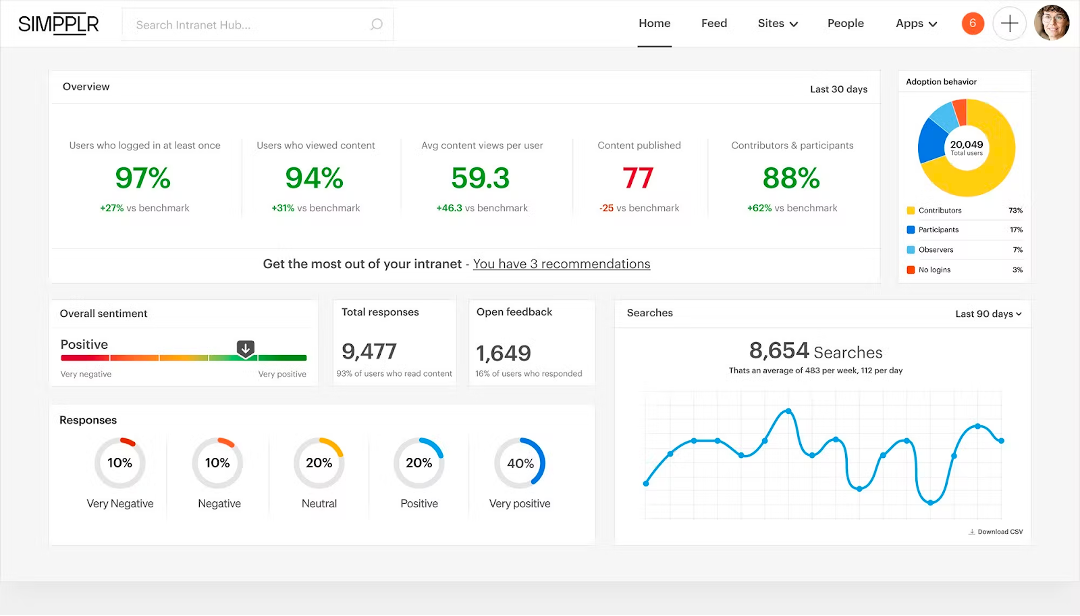
A dashboard shows different intranet usage metrics in Simpplr (Source)
/ Planning in practice
One of the best ways to measure the effectiveness of your communications is to determine how successful you were in achieving the goal you defined at the outset. Ahead of sending out your next communications, brainstorm what KPIs you can use to determine if you met your goal.
Communicate like a pro—download our communication action plan template
You know the score: Failing to communicate effectively with your workforce can lead to disengagement, productivity (and profit) losses, and at the very worst, lawsuits.
Build an HR communication plan in six steps:
Develop an action plan
Define your purpose
Choose the right channels
Focus on messaging
Prepare managers to support employees
Measure results of your communication strategy
Lastly, we’ve created a free communication action plan template that can help you put these steps into action. Download it now to start communicating like a pro.


